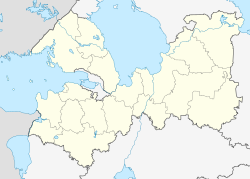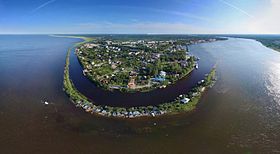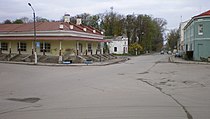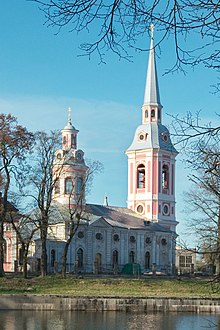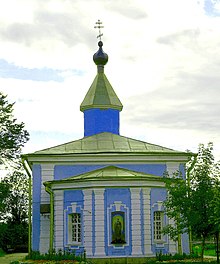Key castle
| city
Schlüsselburg
Шлиссельбург
|
||||||||||||||||||||||||||||||||||||||
|
||||||||||||||||||||||||||||||||||||||
|
||||||||||||||||||||||||||||||||||||||
| List of cities in Russia | ||||||||||||||||||||||||||||||||||||||
Schlüsselburg ( Russian Шлиссельбург , from 1944 to 1992 Петрокрепость / Petrokrepost , in the Middle Ages Орешек / Oreshek ; historically Swedish Nöteborg , Finnish Pähkinälinna ) is a town on the left bank of the Neva , where these the Lake Ladoga leaves, 35 kilometers east of St. Petersburg . The city of Leningrad Oblast has 13,170 inhabitants (as of October 14, 2010).
The historic old town and the fortress of Shlisselburg on a river island in front of the city were included in the list of world cultural and natural heritage of humanity by UNESCO in 1990.
history
Middle Ages and Early Modern Times
Before the actual settlement, a wooden fortress was built in the same place on the offshore island in the Neva in the 14th century. According to Russian historiography, the fortress was built by Yuri I Daniilowitsch , the Grand Duke of Moscow and Prince of Novgorod at the same time. According to the Swedish version, the island was first fortified in 1299 by the Swede Torgils Knutsson .
In 1323 negotiations were held in the fortress about the Russian-Swedish border in Karelia , the conclusion is usually referred to as the Treaty of Nöteborg in German historiography . The fortress itself remained with Novgorod . In May 1612 the fortress fell to Sweden after nine months of siege in the Ingermanland War . During the Great Northern War , Peter I was finally able to recapture the fortress for Russia in 1702 after ten days of shelling . He then gave the fortress the German name “Schluesselburg”, probably because he saw it as the “key” to conquering an access to the Baltic Sea.
On the left bank of the Neva, the Schliisselburg settlement also developed from 1702. It received city status in 1780. Its layout was shaped by the canal and lock systems of the Ladoga Canal, which was built in 1719 and is important for Neva shipping .
Modern times
On September 8, 1941, after heavy fighting, it was captured by the German Wehrmacht . On January 18, 1943, the city was recaptured by the Red Army as part of Operation Iskra .
In 1944, in the course of the eradication of German place names after Peter the Great in Petrokrepost (Петрокрепость, literally “St. Peter's Fortress”), Schlüsselburg was renamed. In 1992 the city got its old name back.
Population development
| year | 1897 | 1939 | 1959 | 1970 | 1979 | 1989 | 2002 | 2010 |
| Residents | 5,284 | 9,715 | 7.164 | 8,466 | 10,212 | 12,589 | 12,401 | 13.305 |
Note: census data
economy
There are several shipyards in Schluesselburg.
traffic

The Petrokrepost train station on the other bank of the Neva across from Shlisselburg connects with the Ladoga train station in St. Petersburg.
The highways A 120 , which surrounds St. Petersburg, and R21 , which connects St. Petersburg and Murmansk , run a few kilometers south of the city.
The Neva and Lake Ladoga are navigable. The new Ladoga Canal , which begins as part of the Volga-Baltic Sea Canal near Schluisselburg, connects the Volkhov with the Neva.
architecture
Few historical buildings have survived, apart from a few churches from the 18th century. Perhaps the most remarkable sight is the Old Ladoga Canal, which was started at the behest of Peter the Great in 1719 and completed twelve years later under the direction of Field Marshal Münnich .
See also
Individual evidence
- ↑ a b Itogi Vserossijskoj perepisi naselenija 2010 goda. Tom 1. Čislennostʹ i razmeščenie naselenija (Results of the All-Russian Census 2010. Volume 1. Number and distribution of the population). Tables 5 , pp. 12-209; 11 , pp. 312–979 (download from the website of the Federal Service for State Statistics of the Russian Federation)
- ^ Harrison E. Salisbury: 900 days. The siege of Leningrad (= Fischer pocket books 4425 history ). Unabridged edition. Fischer-Taschenbuch-Verlag, Frankfurt am Main 1989, ISBN 3-596-24425-0 , pp. 319-320.
Web links
- Shlisselburg on mojgorod.ru (Russian)



